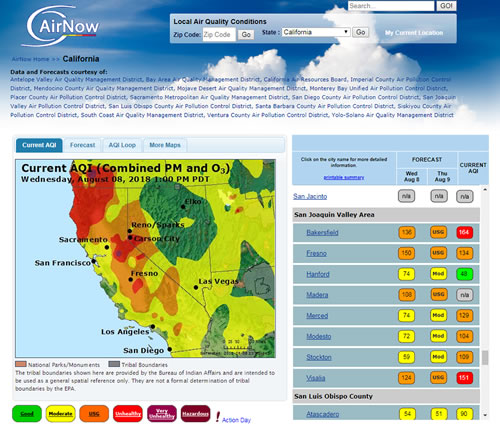Wildfire smoke means possible Respiratory Protection for Outdoor Workers
Living in Southern California, like a large number of our clients, friends and family, these Wildfires are affecting our air quality, and our health. As employers, this means even more responsibility for outdoor workers, and Cal OSHA issued an advisory to help keep your compliant, and your workers safe.
Employers need to provide N95 or better protection for unhealthy out door air quality due to wildfires according to Cal OSHA ( shown below ).
This appears to necessitate all of the requirements in a respiratory protection program, not voluntary use, when levels are as high as they have been.
This may be debatable and tough to enforce, imagine having every employer in the central valley needing medical questionnaires for any worker using an N95 due to Wildfire smoke.
This is something we all need to keep in mind, especially thinking about workers, family and friends in our region... especially with conditions like the report for August 8th, shown below. Click image for larger image.
To view todays air quality, click here to visit airnow.gov
Cal/OSHA Issues Advisory for Worker Safety in Wildfire Regions
Link to PDF - https://www.dir.ca.gov/DIRNews/2018/2018-50.pdf
News Release No.: 2018-50
Date: July 5, 2018Oakland—Cal/OSHA is advising employers that special precautions must be taken to protect workers from hazards from wildfire smoke.
Smoke from wildfires contains chemicals, gases, and fine particles that can harm health. The greatest hazard comes from breathing fine particles, which can reduce lung function, worsen asthma and other existing heart and lung conditions, and cause coughing, wheezing and difficulty breathing.
Guidance for employers and workers on working safely in conditions with heavy smoke caused by the wildfires is available on Cal/OSHA’s web page, including frequently asked questions about N95 masks for employers and workers.
Employers with operations exposed to wildfire smoke must consider taking appropriate measures as part of their Injury and Illness Prevention Program under Title 8 section 3203 of the California Code of Regulations and as required under section 5141 (Control of Harmful Exposure to Employees).
Read the full advisory here - https://www.dir.ca.gov/DIRNews/2018/2018-50.pdf
Air Quality Index
AQI Ranges below, including descriptions, originally found on Environment Protection Agency website https://airnow.gov/
The AQI is an index for reporting daily air quality. It tells you how clean or polluted your air is, and what associated health effects might be a concern for you. The AQI focuses on health effects you may experience within a few hours or days after breathing polluted air. EPA calculates the AQI for five major air pollutants regulated by the Clean Air Act: ground-level ozone, particle pollution (also known as particulate matter), carbon monoxide, sulfur dioxide, and nitrogen dioxide. For each of these pollutants, EPA has established national air quality standards to protect public health .Ground-level ozone and airborne particles are the two pollutants that pose the greatest threat to human health in this country.
For more information on the AQI - please visit this link
AQI: Good (0 - 50)
Air quality is considered satisfactory, and air pollution poses little or no risk.
AQI: Moderate (51 - 100)
Air quality is acceptable; however, for some pollutants there may be a moderate health concern for a very small number of people who are unusually sensitive to air pollution.
AQI: Unhealthy for Sensitive Groups (101 - 150)
Although general public is not likely to be affected at this AQI range, people with lung disease, older adults and children are at a greater risk from exposure to ozone, whereas persons with heart and lung disease, older adults and children are at greater risk from the presence of particles in the air.
AQI: Unhealthy (151 - 200)
Everyone may begin to experience health effects members of sensitive groups may experience more serious health effects.
AQI: Very Unhealthy (201 - 300)
Health alert: everyone may experience more serious health effects.
AQI: Hazardous (301 - 500)
Health warnings of emergency conditions. The entire population is more likely to be affected
Stay safe, and keep inside as much as possible when Air quality is low.
CSTC

